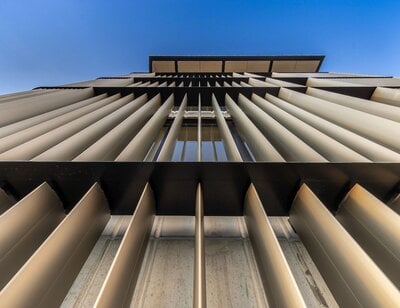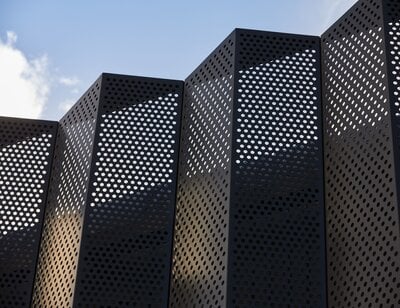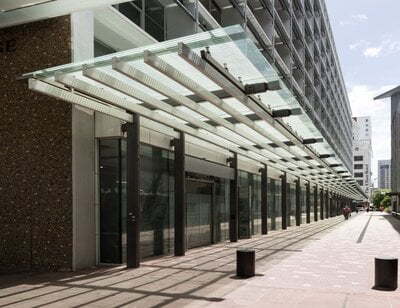Prior to 1849 it was possible to tell the wealth of a person in England by the number and size of their... windows. Yes, windows. Ever since King William lll implemented the Window Tax in 1696, Glass had been used as a source of income for the crown. The reasoning was straightforward. If you could afford a fancy house with lots of big windows then you must be rich and should cough up. We note Buckingham Palace (opening 1705) has 760 windows. It must have been quiet the outlandish display of wealth and no doubt had a few locals coughing into their nettle soup when they heard.
We mention this because of the impact of the abolishment of the Glass Excise Tax. Unburdened by the shackles of this vastly unfair tax that kept poor people (literally) in the dark, glass was suddenly everywhere. Including shop fronts. With nothing to hold them back financially, shopkeepers opened up their shopfronts with large windows, exposing their products to the world. This did two things. Firstly, it created a new vocation for people who could arrange window displays (the billboards of their day) to attract the punters. Secondly, it created the need for canopies, to protect the displays and goods on sales (and the punters) from the perils of England's harsh (and occasionally damp) sunlight.
One of the earliest beneficiaries of this was Tom Dean. A policemen's son, he started the company company Deans Blinds of Putney in 1894, and began making blinds for high street stores. Some of the most iconic images of the Victorian High Street will feature their work. Rather wonderfully, many images of London today do too. Deans Blinds is still alive and well.
Canopy, Awning or Verandah?
Strictly speaking, what Tom Dean was making was an awning. He may have called them blinds, based on their ability to shied from the sun, yet an awning is more exact being 'a sheet of canvas or other material stretched on a frame and used to keep sun or rain off a shop window or doorway.' Which is pretty much what the Oxford Dictionary says. We note before getting into awnings, Tom Dean was big in the canvas bag industry.
A verandah (noting the 'h' - which is the traditional English spelling, later removed in American-English and now missing in general) is sometimes used when talking about canopies. But this is a little misleading too. As the Cambridge Dictionary points out with the sentence; 'every evening we sat on the verandah to watch toe sun go down.' They see a verandah as a 'raised, covered, sometimes partially closed area, often made of wood, on the front or side of a building.; So we're not really making verandahs as you generally don't park trucks underneath them. Not without really annoying the homeowner anyway.
We've decided canopy is the best term. Which is seemingly stupid given it's defined as a 'cover fixed over a seat or bed, for shelter or decoration.' Granted this might seem the farthest removed from what we're talking about but it is the best 'cover-all term' (no pun intended). This is because it's generally understood by people to mean 'something overtop of my head'. For example, you walk beneath a canopy of stars. You take shelter under a tree canopy. It just makes sense... and the dictionary doesn't. Right, now that's cleared up...
What Are Canopies For?
Weather Protection
As per their original purpose, canopies still protect from the sun. They also offer a degree of protection from the wind and rain, especially if we're talking about canopies in the context of covered walkways or canopies overtop of loading/unloading areas in an industrial or hospitality setting. The weather protection from canopies is arguably more important than consciously obvious when walking down the High Street. That extra level of comfort reduces the need to rush, providing more time to visually pursue whatever the display merchandisers have created to get some attention. This lack of haste correlates to an increased propensity to purchase. In other terms, get people to spend long enough looking at your window display and they'll find something they want to buy. This makes canopies good for business.
Another thing that's good for business is having your customers able to reach you in the first place. Which is why a special mention about wind is needed. One of the unintended consequences of building upwards is the redirection of wind force. Toronto is a perfect example of what can happen as a result of down washing, channelling and corner vortexing. In 1986, Toronto had to install climbing ropes so pedestrians could hold onto something to prevent being bowled over by the wind. Nearer to home, Wellington is an example of a place where wind can be problematic and that's why canopies are a requirement as part of the resource consent. Canopies do a good job of disrupting pedestrian level wind.
Architectural Feature
Canopies can attract people to an area. You might not consciously walk somewhere whilst muttering, 'oh - look at that wonderful canopy' to yourself (although we might) but as a feature and part of an overall design, they add something unique to the streetscape. They can be as visually inviting as they are physically inviting, drawing pedestrians to an area and then helping keep them there. They help provide the essential human scale required, particularly in a built environment where buildings imposingly reach for the sky.
Interestingly, canopies also add to the character and sense of a place. There is an undeniable style to downtown Paris. As there is to the streets of Milan. Both tend to favour fabric type lightweight awnings although it's hard to discern exactly why. At a guess, it's simply 'how its done' and they fit the charm of the old buildings well.
Back in London, despite the gloomy weather, there has never been a widespread adoption of canopies beyond smaller awnings from the likes of Deans Blinds. One suggested reason is the need for Fire Engines to mount the footpath so they can quickly navigate past traffic jams. There may be some truth to this. Since 1974, Highway Code rule 244 has stated drivers 'must not park partially or wholly on the pavement in London'. This rule was made to make sure nothing would block emergency services from getting close to a building. So there's a similar train of thought evident.
Our cousins across the Tasman are, unsurprisingly, similar to us here in NZ. Interestingly, in 1908 they outlawed canopies supported by posts... it seems there was an issue when the motor car was still rather new, when novice drivers made a habit of wiping out the posts supporting canopies in downtown Sydney. Hence you'll only find post supported canopies in certain heritage districts.
Canopy Rules & Regulations
The law change in Sydney is an early example of the rules impacting canopies. Open the pages of any Council Plans nowadays and you'll find a whole lot more. So what do they say?
Well, it varies from Council Council. Down here in Invercargill (where canopies are referred to as Verandahs - using the proper English spelling): 'within the Pedestrian Friendly Frontages Precinct all buildings are to be provided with verandahs across the public footpath for the full width of the site frontages.' They are subject to maximum height restrictions of 3.5 metres, must be set back 0.6 metres from the road and 'be so related to verandahs on adjacent buildings as to provide continuous weather protection for pedestrians.' The Council is obviously predicting there might be some rain down here.
Those rules are not unusual and in Auckland key retail frontages demand developers to do much the same, with a minimum height for canopies, which must also be set back from the kerb. They must also have lighting incorporated for use outside of daylight hours.
We had often wondered by canopies were not deleted during value engineering and these rules provide the answer. After all, there has to be some reason why there's a need to persevere given the complications that can plague canopy installation...
Canopies & the Facade: Improving Installation
Common canopy construction methods can include a lot of consultant effort and time. There are concentrated layers of sub-contractors, with many interdependencies. There's often structural steel, carpentry, waterproofing, cladding, electrical, and plumbing and drainage contractors all working within a confined space. Each carries a risk of delay and complication. We can simplify all of this. We've started bringing canopy construction all under one roof. Our designs are simple, customisable, manufactured offsite, and best of all, quick. There is no need to coordinate all those different trades in such a confined location.
Some of our designs are proprietary, others are completely customised to meet an architectural intent. Whatever suits your project best, we can provide it.
Our canopies are the natural progression from the canvas awnings offered by Tom Dean, back in Victorian England. We're using modern construction methods and materials that require less maintenance. Their looks don't dominish and they won't be damaged by the weather (as is the case with canvas canopies). So they have a sense of permanence and are fit for purpose for the modern world.
Hopefully, around 2197, there'll be a blog being written which will reference Insol canopies. We'd like to think they'd note we're still going strong too.... with Insol continuing to work with architects and builders in New Zealand, and playing a part in the construction industry. We're confident our canopies will still be there and looking good anyway.








